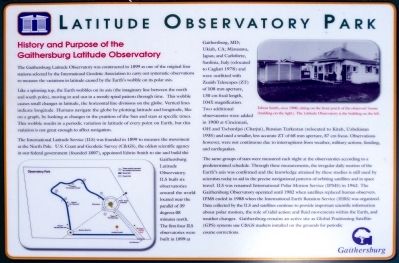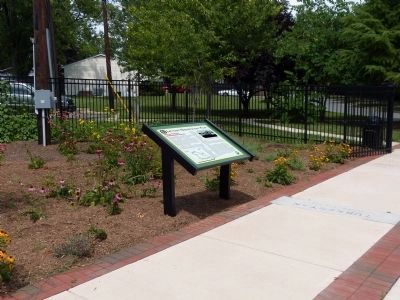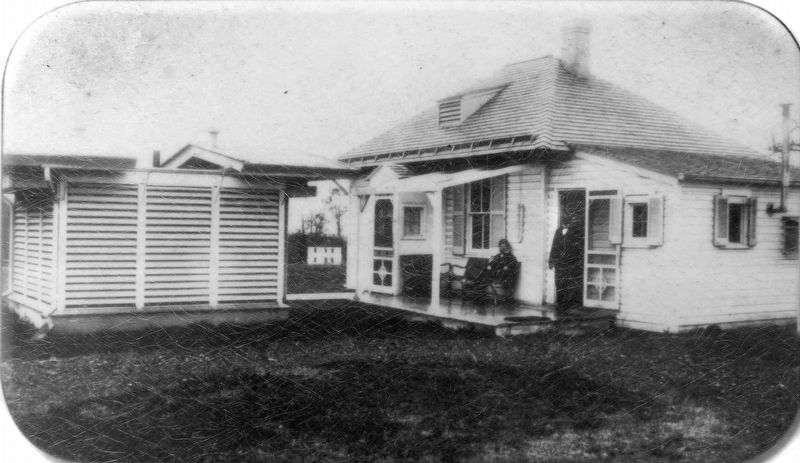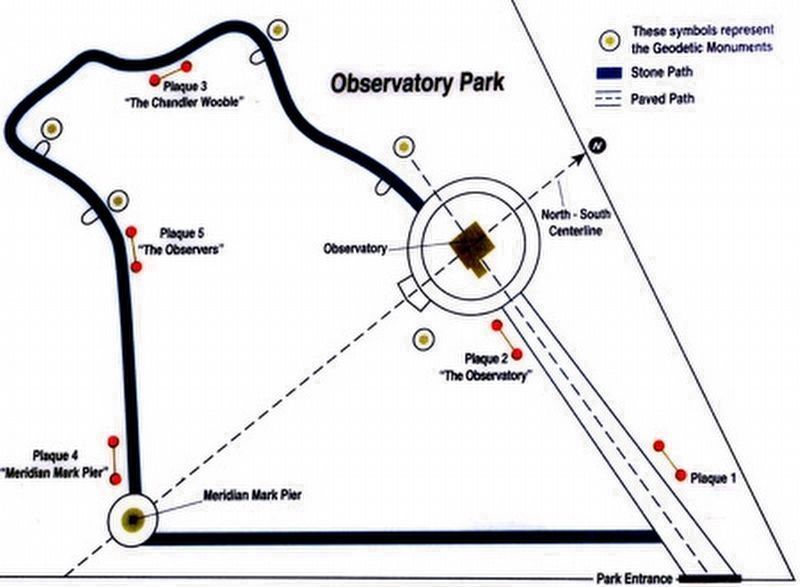Gaithersburg in Montgomery County, Maryland — The American Northeast (Mid-Atlantic)
History and Purpose of the Gaithersburg Latitude Observatory
Latitude Observatory Park
Inscription.
The Gaithersburg Latitude Observatory was constructed in 1899 as one of the original four stations selected by the International Geodetic Association to carry out systematic observations to measure the variations in latitude cause by the Earth's wobble on its polar axis.
Like a spinning top, the Earth wobbles on its axis (the imaginary line between the north and south poles), moving in and out in a mostly spiral pattern through time. This wobble causes small changes in latitude, the horizontal line divisions of the globe.Vertical lines indicate longitude. Humans navigate the globe by plotting latitude and longitude, like on a graph, by looking at changes in the position of the Sun and stars at specific times. This wobble results in periodic variation in latitude of every point on Earth, but this variation is not great enough to affect navigation.
The International Latitude Service (ILS) was founded in 1899 to measure the movement at the North Pole. U.s. Coast and Geodetic Survey (C&GS), the oldest scientific agency in our federal government (founded 1807), appointed Edwin Smith to site and build the Gaithersburg Latitude Observatory. ILS built six observatories around the world located near the parallel of 39 degrees 08 minutes north. The first four ILS observatories were built in 1899 at Gaithersburg, MD; Ukiah, CA; Mizusawa, Japan; and Carloforte, Sardinia, Italy (relocated to Cagliari in 1978) and were outfitted with Zenith Telescopes (ZT) of 108 mm focal length,104X magnification. Two additional observatories were added in 1990 at Cincinnati OH and Tscharjui (Charjui), Russian Turkestan (relocated to Kitab, Uzbekistan 1935) and used smaller less accurate ZT of 68mm aperture, 87 cm focus. Observations however, were not continuous due to interruptions from weather, military actions, funding, and earthquakes.
The same groups of stars were measured each night at the observatories according to a predetermined schedule. Through these measurements, the irregular daily motion of the Earth's axis was confirmed and the knowledge attained by the studies is still used by scientists today to aid in the precise navigational patterns of orbiting satellites and in space travel. ILS was renamed International Polar Motion Service (IPMS) in 1962. The Gaithersburg Observatory operated until 1982 when satellites replaced human observers. IPMS ended in 1988 when the International Earth Rotation Service (IERS) was organized. Data collected by the ILS and satellites continue to provide important scientific information about polar motion, the role of tidal action and fluid movements within the Earth, and weather changes. Gaithersburg remains an active site as Global Positioning Satellite (GPS) systems
use C&GS markers installed in the grounds for periodic course corrections.
Erected 2011 by the City of Gaithersburg.
Topics and series. This historical marker is listed in this topic list: Science & Medicine. In addition, it is included in the National Historic Landmarks series list. A significant historical year for this entry is 1899.
Location. 39° 8.204′ N, 77° 11.896′ W. Marker is in Gaithersburg, Maryland, in Montgomery County. Marker is on DeSellum Avenue, 0.2 miles west of George Street, on the right when traveling west. Touch for map. Marker is at or near this postal address: 100 DeSellum Avenue, Gaithersburg MD 20877, United States of America. Touch for directions.
Other nearby markers. At least 8 other markers are within walking distance of this marker. The Observatory (within shouting distance of this marker); Meridian Mark Pier and Geodetic Survey Monuments (within shouting distance of this marker); A Night at the Gaithersburg Latitude Observatory (about 300 feet away, measured in a direct line); The Chandler Wobble (about 300 feet away); General Edward Braddock (approx. ¼ mile away); The Gaithersburg Wye (approx. 0.3 miles away); DeSellum Family Cemetery (approx. 0.3 miles away); Schwartz House / City Hall (approx. 0.3 miles away). Touch for a list and map of all markers in Gaithersburg.
Additional keywords. Geodesy
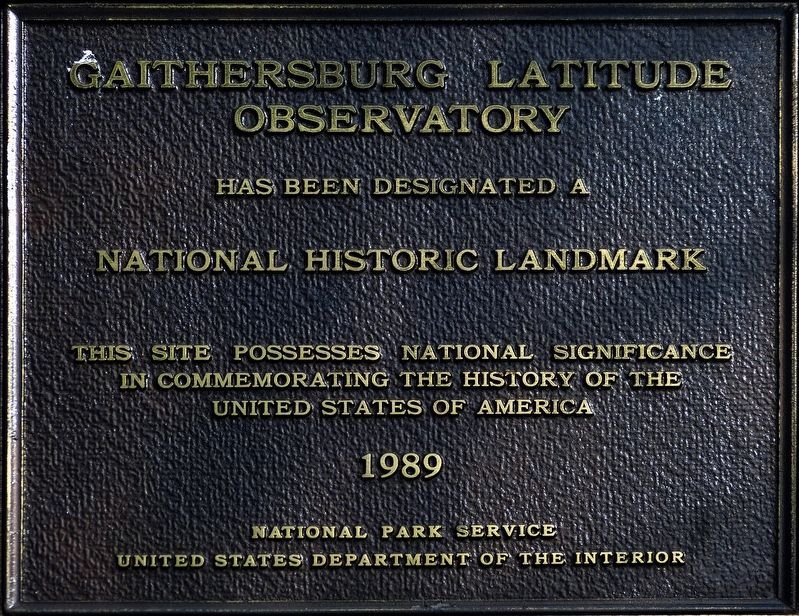
Photographed By Allen C. Browne, July 15, 2012
5. Historic Landmark
Observatory
has been designated a
National Historic Landmark
This Site possesses National Significance
in Commemorating the History of the
United States of America
1989
National Park Service
United States Department of Interior
Credits. This page was last revised on September 22, 2019. It was originally submitted on July 1, 2012, by Allen C. Browne of Silver Spring, Maryland. This page has been viewed 661 times since then and 24 times this year. Last updated on January 17, 2019, by Bruce Guthrie of Silver Spring, Maryland. Photos: 1. submitted on July 1, 2012, by Allen C. Browne of Silver Spring, Maryland. 2. submitted on July 18, 2012, by Allen C. Browne of Silver Spring, Maryland. 3, 4. submitted on August 4, 2019, by Allen C. Browne of Silver Spring, Maryland. 5. submitted on August 5, 2019, by Allen C. Browne of Silver Spring, Maryland. • Andrew Ruppenstein was the editor who published this page.
